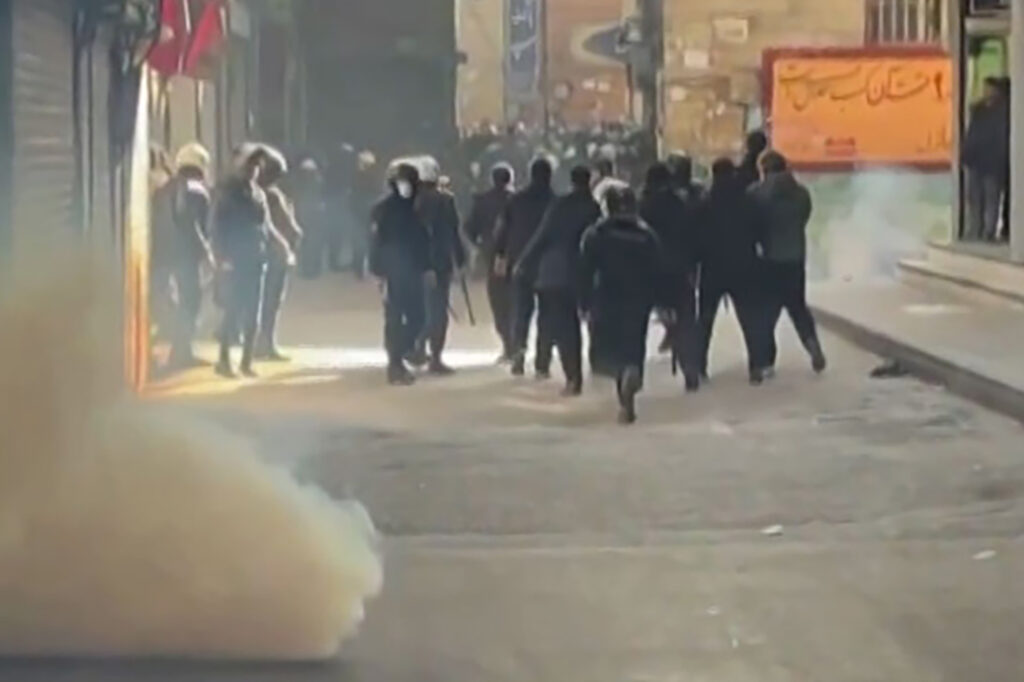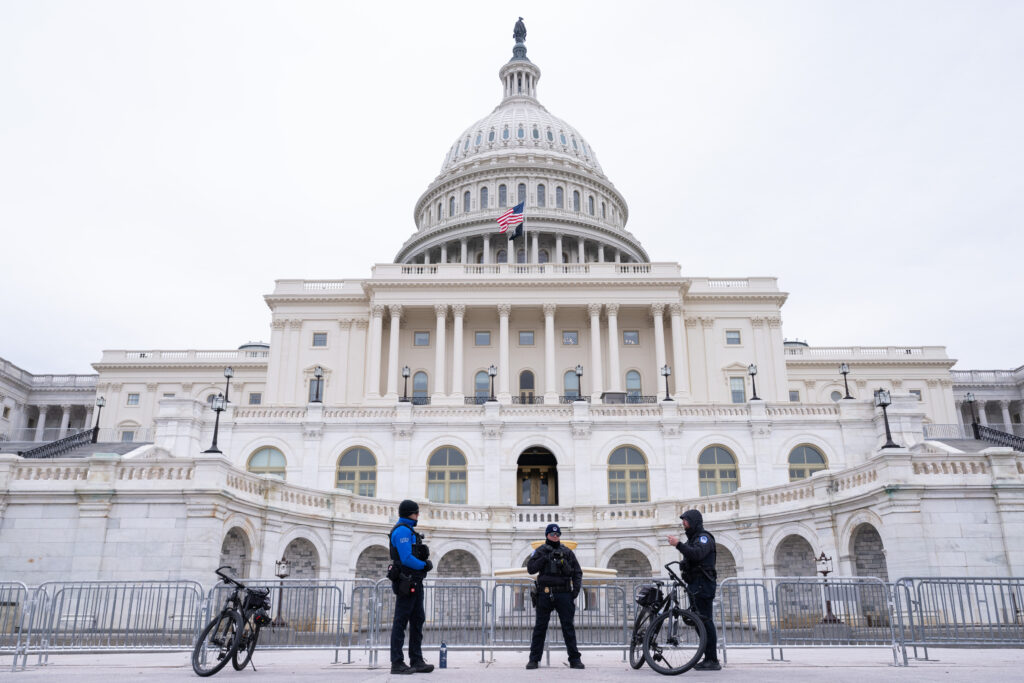CAN-2025: l’Algérie sort la RDC et affrontera le Nigeria en quart
L’Algérie s’est qualifiée mardi pour les quarts de finale de la CAN-2025 en éliminant la RD Congo (1-0) tout au bout d’une prolongation irrespirable grâce à un but d’Adil Boulbina à la 119e minute.Les Fennecs du sélectionneur Vladimir Petkovic affronteront au prochain tour le Nigeria, facile vainqueur du Mozambique lundi (4-0). Peut-être sans leur plaque tournante du milieu de terrain Ismael Bennacer, sorti blessé après 48 minutes de jeu, apparemment touché à l’ischio-jambier de la cuisse droite.L’aventure continue donc pour les Algériens, avec une statistique qui leur permet les plus beaux rêves: ils sont sortis de la phase de poules avec trois victoires en trois matches. C’est la troisième fois que cela leur arrive après 1990 et 2019. Et les deux premières fois, ils ont soulevé le trophée au soir de la finale.Ils ont arraché la victoire in extremis. Lancé en contre sur la gauche, Boulbina a crocheté pour effacer Aaron Wan-Bissaka et, de l’entrée de la surface, a placé un tir enveloppé du droit parfait dans la lucarne opposée (1-0, 119e).Dans cette affiche contre la RD Congo, sur le papier la plus relevée des 8e, l’Algérie a eu la possession. Les Congolais, bloc bas et pressing intense, ont placé des banderilles. Entre ces deux formations qui se craignaient et ont fait preuve d’une belle rigueur tactique, il aurait fallu une erreur individuelle, ou un exploit personnel, pour débloquer le score plus tôt.Mais voilà, les Fennecs du coach Vladimir Petrovic, comme les Léopards du Français Sébastien Desabre n’ont rien lâché pendant presque deux heures. Et les deux gardiens, Luca Zidane pour l’Algérie et Lionel Mpasi-Nzau pour le Congo, ont fait le reste pour préserver leurs cages.La première période a été un très long round d’observation. Les Fennecs ont même attendu la 42e minute pour placer leur premier tir, non cadré, par leur pépite de 20 ans Ibrahim Maza.Le jeu s’est accéléré et l’intensité est montée d’un cran en deuxième période. Chancel Memba (50e), Joris Kayembe (74e), Ibrahim Mayle (90+2) ont eu leur chance pour la RDC, Mohamed Amoura (79e) et Anis Hadj Moussa (86e) pour l’Algérie ont buté sur le gardien congolais.Mais l’arbitre a sifflé la fin du temps réglementaire sur le score de 0-0. En prolongation, aucune des deux équipes n’a fermé le jeu. L’Algérie s’est d’abord procuré une superbe occasion par Fares Chaibi, qui a obligé Mpasi-Nzau à un sauvetage réflexe sur sa ligne (110e). Neuf minutes plus tard, Boulbina propulsait les Fennecs dans le top-8 africain.
CAN-2025: l’Algérie sort la RDC et affrontera le Nigeria en quart
L’Algérie s’est qualifiée mardi pour les quarts de finale de la CAN-2025 en éliminant la RD Congo (1-0) tout au bout d’une prolongation irrespirable grâce à un but d’Adil Boulbina à la 119e minute.Les Fennecs du sélectionneur Vladimir Petkovic affronteront au prochain tour le Nigeria, facile vainqueur du Mozambique lundi (4-0). Peut-être sans leur plaque tournante du milieu de terrain Ismael Bennacer, sorti blessé après 48 minutes de jeu, apparemment touché à l’ischio-jambier de la cuisse droite.L’aventure continue donc pour les Algériens, avec une statistique qui leur permet les plus beaux rêves: ils sont sortis de la phase de poules avec trois victoires en trois matches. C’est la troisième fois que cela leur arrive après 1990 et 2019. Et les deux premières fois, ils ont soulevé le trophée au soir de la finale.Ils ont arraché la victoire in extremis. Lancé en contre sur la gauche, Boulbina a crocheté pour effacer Aaron Wan-Bissaka et, de l’entrée de la surface, a placé un tir enveloppé du droit parfait dans la lucarne opposée (1-0, 119e).Dans cette affiche contre la RD Congo, sur le papier la plus relevée des 8e, l’Algérie a eu la possession. Les Congolais, bloc bas et pressing intense, ont placé des banderilles. Entre ces deux formations qui se craignaient et ont fait preuve d’une belle rigueur tactique, il aurait fallu une erreur individuelle, ou un exploit personnel, pour débloquer le score plus tôt.Mais voilà, les Fennecs du coach Vladimir Petrovic, comme les Léopards du Français Sébastien Desabre n’ont rien lâché pendant presque deux heures. Et les deux gardiens, Luca Zidane pour l’Algérie et Lionel Mpasi-Nzau pour le Congo, ont fait le reste pour préserver leurs cages.La première période a été un très long round d’observation. Les Fennecs ont même attendu la 42e minute pour placer leur premier tir, non cadré, par leur pépite de 20 ans Ibrahim Maza.Le jeu s’est accéléré et l’intensité est montée d’un cran en deuxième période. Chancel Memba (50e), Joris Kayembe (74e), Ibrahim Mayle (90+2) ont eu leur chance pour la RDC, Mohamed Amoura (79e) et Anis Hadj Moussa (86e) pour l’Algérie ont buté sur le gardien congolais.Mais l’arbitre a sifflé la fin du temps réglementaire sur le score de 0-0. En prolongation, aucune des deux équipes n’a fermé le jeu. L’Algérie s’est d’abord procuré une superbe occasion par Fares Chaibi, qui a obligé Mpasi-Nzau à un sauvetage réflexe sur sa ligne (110e). Neuf minutes plus tard, Boulbina propulsait les Fennecs dans le top-8 africain.
Iran security forces use tear gas in Tehran bazaar as toll rises
Iranian security forces fired tear gas to disperse demonstrators at the Tehran bazaar on Tuesday, as an NGO said more than two dozen people had been killed in a crackdown on the most significant protests to hit the Islamic republic in three years.The protests were triggered by anger over the rising cost of living, with the Iranian rial losing value again on Tuesday to reach another record low against foreign currencies.Security forces have now killed at least 27 protesters, including five minors under the age of 18, the Norway-based NGO Iran Human Rights (IHR) said. Iranian authorities say members of security forces have also been killed, including a policeman who was shot dead on Tuesday.The protest wave began on December 28 with a shutdown by merchants in the Tehran bazaar, a national economic hub. They have since spread to other areas, especially the west, which is home to Kurdish and Lor minority groups.It is the most serious protest movement in Islamic republic since the 2022-2023 nationwide rallies sparked by the death in custody of Mahsa Amini, who had been arrested for allegedly violating the strict dress code for women.Iran’s Fars news agency said “sporadic gatherings” took place around the bazaar during an afternoon shutdown, with police dispersing the protest and demonstrators scattering into the alleyways nearby. In social media footage verified by AFP, protesters at the scene could also be heard shouting slogans including “Pahlavi will return” and “Seyyed Ali will be overthrown” — references to the monarchy ousted by the 1979 Islamic revolution and to supreme leader Ayatollah Ali Khamenei.Dozens of people are seen shouting “freedom” and “shameless” in footage posted by IHR and the US-based Human Rights Activists News Agency (HRNA). Security forces then fire tear gas at the protesters, who rush to disperse as acrid smoke rises from the ground. The official IRNA news agency said “some” people were arrested, without giving numbers.With protests continuing in other areas for a tenth day, HRNA posted footage of large crowds of people marching in protests through Abdanan in western Iran shouting slogans including “this is the last message, the entire regime is the target”.- ‘Crush dissent’ -The demonstrations have yet to reach the scale of the 2022-2023 movement, let alone that of the mass 2009 street protests that followed disputed elections.But against the background of an economic crisis and on the heels of the 12-day war against Israel in June, they present a new challenge for the leadership under 86-year-old Khamenei, in power since 1989.The government of President Masoud Pezeshkian has announced modest monthly payments for people to alleviate the economic pain, but the head of the judiciary warned Monday that there would be no leniency for “rioters”.According to official announcements in Iranian media, at least 13 people have been killed since the protests began, including members of the security forces. But IHR said: “At least 27 protesters have been killed by gunfire or other forms of violence carried out by security forces in eight provinces. Five of those killed have been verified to have been children.”It added that more than 1,000 people had been arrested nationwide.IHR said security forces killed at least six people in a single incident alone on Saturday when they opened fire on protesters in the Malekshahi district of the western Ilam province.It also accused authorities of raiding the main hospital in Ilam the day after to detain injured protesters.Amnesty International said on Tuesday that the “attack” on the hospital “exposes yet again how far the Iranian authorities are willing to go to crush dissent”.Pezeshkian has ordered his interior minister to investigate “thoroughly, comprehensively and expertly” what happened in Ilam province, according to the presidential website.With tensions continuing in the area, a policeman was shot dead Tuesday after being “directly hit by rioters’ bullet” in Malekshahi, the Fars news agency said.IHR said Iranian authorities also raided a hospital in the Hasanabad district of Tehran Tuesday, firing tear gas.The Iranian currency meanwhile fell in value to approximately 1.47 million rials to the dollar, according to the informal black market rate and several currency monitoring websites. On December 28, a previous low in the rial — then at 1.43 million to the dollar — had driven traders into the streets and sparked the protest movement.
L’Américaine Freida McFadden écrase les ventes de livres en France en 2025
La romancière américaine Freida McFadden est arrivée en tête du classement des ventes de livres en France en 2025, en plaçant huit de ses romans dans les 15 premiers de la liste publiée mardi par Livres Hebdo.La discrète autrice a confirmé la première place qu’elle avait prise en 2024 avec son roman phénomène “La femme de ménage”, un “thriller psychologique” dont le premier tome est sorti en 2022 en anglais et un an plus tard en 45 langues dont le français.Selon le classement du site de référence Livres Hebdo, réalisé par NielsenIQ BookData – GFK, les romans de Freida McFadden, dont les quatre tomes de “La femme de ménage”, prennent toutes les premières places en grand format (éditions City) et en poche (J’ai lu), à l’exception de la deuxième, occupée par le nouvel album d’Astérix, “Astérix en Lusitanie” (édition Albert René) et de la sixième, que prend “La maison vide” (Minuit) de Laurent Mauvignier, prix Goncourt.Le classement des essais est dominé par Salomé Saqué avec “Résister” (Payot), “L’heure des prédateurs” (Gallimard) de Giuliano Da Empoli et “Le journal d’un prisonnier” (Fayard) de Nicolas Sarkozy, sorti en décembre.Livres Hebdo souligne que Fayard, la maison du groupe Hachette, sous le contrôle du milliardaire conservateur Vincent Bolloré, place cinq titres politiques dans le classement de 50 livres, dont ceux de Jordan Bardella (“Ce que veulent les Français”), Éric Zemmour (“La messe n’est pas dite”) et deux titres de Philippe de Villiers (“Populicide” et “Mémoricide”).”L’ensemble dessine un marché de l’essai en 2025 structurellement polarisé, où le débat politique hexagonal et les faits divers judiciaires captent l’essentiel de l’attention éditoriale”, indique Livres Hebdo.Derrière Astérix, le classement des BD et mangas est dominé par le youtubeur Inoxtag, avec deux tomes de son manga “Instinct” (Michel Lafon), le tome 110 du manga japonais “One Piece” (Glénat), tandis que la dernière aventure de Blake et Mortimer, “La menace Atlante”, occupe la 5e place. La série jeunesse à succès “Mortelle Adèle” (Mr Tan & Co) place six volumes dans le top 20, selon Livres Hebdo.
L’Américaine Freida McFadden écrase les ventes de livres en France en 2025
La romancière américaine Freida McFadden est arrivée en tête du classement des ventes de livres en France en 2025, en plaçant huit de ses romans dans les 15 premiers de la liste publiée mardi par Livres Hebdo.La discrète autrice a confirmé la première place qu’elle avait prise en 2024 avec son roman phénomène “La femme de ménage”, un “thriller psychologique” dont le premier tome est sorti en 2022 en anglais et un an plus tard en 45 langues dont le français.Selon le classement du site de référence Livres Hebdo, réalisé par NielsenIQ BookData – GFK, les romans de Freida McFadden, dont les quatre tomes de “La femme de ménage”, prennent toutes les premières places en grand format (éditions City) et en poche (J’ai lu), à l’exception de la deuxième, occupée par le nouvel album d’Astérix, “Astérix en Lusitanie” (édition Albert René) et de la sixième, que prend “La maison vide” (Minuit) de Laurent Mauvignier, prix Goncourt.Le classement des essais est dominé par Salomé Saqué avec “Résister” (Payot), “L’heure des prédateurs” (Gallimard) de Giuliano Da Empoli et “Le journal d’un prisonnier” (Fayard) de Nicolas Sarkozy, sorti en décembre.Livres Hebdo souligne que Fayard, la maison du groupe Hachette, sous le contrôle du milliardaire conservateur Vincent Bolloré, place cinq titres politiques dans le classement de 50 livres, dont ceux de Jordan Bardella (“Ce que veulent les Français”), Éric Zemmour (“La messe n’est pas dite”) et deux titres de Philippe de Villiers (“Populicide” et “Mémoricide”).”L’ensemble dessine un marché de l’essai en 2025 structurellement polarisé, où le débat politique hexagonal et les faits divers judiciaires captent l’essentiel de l’attention éditoriale”, indique Livres Hebdo.Derrière Astérix, le classement des BD et mangas est dominé par le youtubeur Inoxtag, avec deux tomes de son manga “Instinct” (Michel Lafon), le tome 110 du manga japonais “One Piece” (Glénat), tandis que la dernière aventure de Blake et Mortimer, “La menace Atlante”, occupe la 5e place. La série jeunesse à succès “Mortelle Adèle” (Mr Tan & Co) place six volumes dans le top 20, selon Livres Hebdo.
Cinq ans après l’assaut du Capitole, démocrates et républicains plus que jamais divisés
Le 6 janvier 2021, des centaines de partisans de Donald Trump prenaient d’assaut le Capitole de Washington, ébranlant la démocratie américaine. Mardi marque le cinquième anniversaire de l’attaque qui, un an après le retour du milliardaire au pouvoir, divise plus que jamais républicains et démocrates.Car loin des condamnations quasi unanimes dans les jours qui avaient suivi l’assaut, le consensus a aujourd’hui disparu au sein de la classe politique. Si les démocrates continuent de dénoncer une attaque envers la démocratie, l’appareil républicain est aujourd’hui dévoué au président de 79 ans, qui a toujours refusé de condamner les actions de ses partisans, évoquant une “journée d’amour” et un “débordement d’affection” à son égard.Le 20 janvier 2025, dès son premier jour de retour à la Maison Blanche, Donald Trump avait gracié l’ensemble des participants, rayant d’un trait de feutre la plus vaste enquête jamais menée par le ministère américain de la Justice.Il a fait brièvement allusion au 6-Janvier lors d’un discours mardi devant des parlementaires républicains, minimisant à nouveau son rôle dans les violences de cette journée.Mais l’opposition démocrate a prévenu qu’elle s’attacherait mardi à garder fraîche la mémoire des événements qui avaient secoué la capitale américaine en 2021.”Il y a cinq ans aujourd’hui, une foule violente a brutalement attaqué le Capitole des Etats-Unis”, a déclaré dans un communiqué Hakeem Jeffries, ténor démocrate au Congrès.”Leur mission était de renverser les résultats d’une élection libre et juste. Nous ne permettrons jamais aux extrémistes d’étouffer leur traîtrise”, a-t-il ajouté.- Marche -Le Parti démocrate a publié un rapport lundi soulignant qu’au moins 33 personnes ayant bénéficié de la grâce de Donald Trump après avoir participé à l’assaut du Capitole ont depuis été inculpées de nouveaux crimes et délits dont, pour certains, agression sexuelle sur mineur, viol, ou encore enlèvement.A l’extérieur du Capitole, des partisans de Donald Trump marqueront également mardi le cinquième anniversaire de l’événement, avec une marche retraçant le parcours effectué en 2021.Parmi les participants: Enrique Tarrio, ancien chef de la milice d’extrême droite Proud Boys qui, jusqu’à la grâce prononcée par Donald Trump, purgeait une peine de 22 ans de prison pour son rôle jugé clé dans les événements du 6-Janvier.La marche rendra notamment hommage, selon ses organisateurs, aux personnes décédées, dont Ashli Babbitt, une manifestante qui avait tenté de se glisser dans l’hémicycle par une vitre brisée avant d’être tuée par balle par un policier. A la suite de son décès, Ashli Babbitt avait été érigée par la droite trumpiste en martyre patriote, et est devenue un symbole des profondes lignes de fracture politiques entourant le 6-Janvier.Si les démocrates veulent faire du bruit pour marquer le cinquième anniversaire, les principaux responsables républicains préfèrent plutôt garder le silence ou critiquer une instrumentalisation de cette journée par l’opposition.- “Comme des diables” -Le 6 janvier 2021, des dizaines de milliers de sympathisants de Donald Trump, alors à la fin de son premier mandat, affluaient à Washington à l’appel du républicain qui affirmait, sans fondement, que l’élection présidentielle perdue quelques semaines plus tôt face à Joe Biden était entachée de fraudes massives.Ce jour-là, Donald Trump a donné devant la Maison Blanche un discours lors duquel il a appelé ses partisans à se “battre comme des diables”, sans quoi leur pays disparaîtrait.Dans les heures qui ont suivi, les manifestants se sont massés devant Capitole, situé à moins de trois kilomètres du lieu du discours, avant de forcer des barrages de police et de pénétrer dans l’enceinte du bâtiment.Fracassant des vitres, saccageant des bureaux, et blessant en tout plus de 140 policiers, ils ont provoqué la fuite des élus qui devaient certifier la victoire de Joe Biden.Au cours des années suivantes, le rôle exact de Donald Trump dans les événements du 6-Janvier a fait l’objet d’une enquête par une commission du Congrès, qui a recommandé en 2022 des poursuites pénales à son encontre. Inculpé en 2023 par un tribunal fédéral pour ses tentatives présumées illicites d’obtenir l’inversion des résultats de l’élection de 2020, il a finalement échappé aux poursuites pénales avec sa victoire à la présidentielle de 2024.






